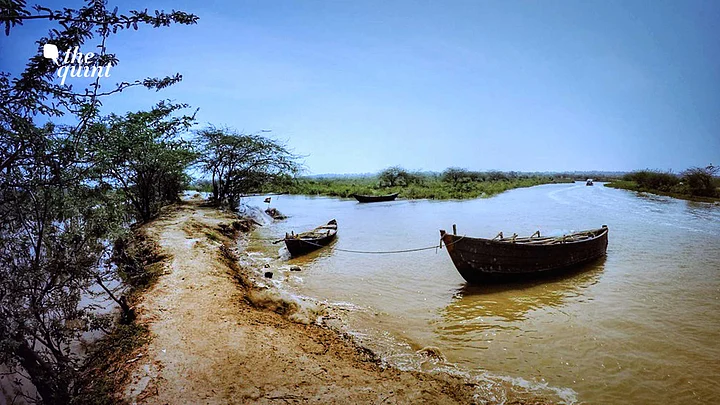Nature restores itself but, with a vengeance. And playing with nature has to have its repercussions in the shape of climatic ravages, for which history may not forgive us.
Odisha, 21 years back, was hit by the unprecedented rage of nature in the shape of the super cyclone, that halted life for 36 hours in almost 14 districts. The eye of the storm was in a place called Ersama in Jagatsinghpur district.
The devastation caused by the super cyclone was so abrupt and so scary that over 10,000 people died and several areas were ravaged irreparably.
But there were areas along the 480-km-long coast of Odisha where nature was unexpectedly kind, and that was because of the mangrove forest cover, which played a barrier between the fury of sea and human habitations.
The Miracle of Mangroves
It was the wide expanse of Bhitarkanika Wildlife sanctuary in Kendrapada district which once enjoyed nature’s fortifications in the form of thick mangrove forests, standing as formidable barrier between the Bay of Bengal and the human settlements around.
The entire area falls under a tropical climatic regime and invasion by oceanic fury had remained a regular feature during the months of April and May.
The frequent reoccurrence of cyclonic storms remain a headache but huge areas remain protected by the rich growth of mangrove forests all along the coast, saving human lives.
However, in the super cyclone that hit Odisha on 29 October 1999, many areas were reduced to barren fields, with no protection of mangrove trees.
But what was remarkable is that long patches along the coast with rich growth of mangrove forests suffered negligible damage, such as Rajnagar division and other areas, which miraculously escaped the fury of the super cylone.
The miracle, in fact, was the mangrove forests.
A Formidable Barrier
Even during the recent Cyclone ‘Yaas,’ some similar surprises were noticed. Amid a cyclone that packed up winds up to 135 to 140 kmph, in the Bhitarkanika Sanctuary, the luxurious cover of mangrove forestry played the role of the most protective barrier in many areas.
Before that, Cyclone ‘Amphan’ had also barrelled through Bhitarkanika, endangering lives, flora and fauna, but major areas withstood the ferocity of the cyclone due to the protective cover of mangrove forests.
Many areas have witnessed seven such oceanic invasions in the last two decades, but right from the 1999 super cyclone, when the wind speed went up to 260 kmph, with gusts almost touching 300 kmph, it has been proved that mangrove forests have stood like walls, saving lives and villages.
“For the villages on the periphery of the Bhitarkanika National Park (declared in 1975), it was the mangrove cover that acted as a buffer zone, protecting human settlements.”Bikash Ranjan Dash, Divisional Forest Officer, Rajnagar Mangrove (Wildlife) Division
Coastal Woodlands Getting Honey-Combed
Odisha, which enjoys the abundance of forests, can also pride itself on having a stretch of 231 sq km of mangrove forest along the coasts.
But sadly, a steady pace of human encroachment has substantially shrunk the mangrove forests for various activities like human settlements, cultivation and unfortunately, the mushrooming growth of prawn cultivation.
Once a patch of mangrove is razed, it requires decades for another patch to grow. Hence, the honey-combing of the mangrove expanse for non-forest purposes is a sad spectacle.
When huge patches of mangroves are razed to create room for prawn ponds, it is a violation of the Coastal Regulation Zone (CRZ) Act, because the areas come within the prohibitory zones of the sanctuary rules.
The mangrove forest in Bhitarkanika is the second largest such concentration after the Sunderbans in West Bengal, otherwise popularly known as the ‘coastal woodlands’.
Heritage In Peril
In Bhitarkanika mangrove forest, there are 67 species of plants. This extends up to Gahirmatha sanctuary, and is considered to be the largest rookery in the world for the Olive Ridley Sea turtles, who seasonally migrate from thousands of kilometers in order to lay eggs.
However, among the 30 species of reptiles found in this sanctuary, the huge salt water crocodiles are supposedly the flagship specie. They indirectly play the role of protectors of the mangrove from unscrupulous elements. Those who venture into the tidal creeks or forests for poaching, fishing and firewood, face the wrath of the crocodiles.
It is the intricate root system that stabilises the coastal regions, thus reducing the impacts of erosion and surges from the sea.
But over the last few decades, an uncontrolled human activity coupled with illegal migrants from Bangladesh have weighed heavy on the mangrove forests. As a result, huge patches of the mangrove forest have disappeared.
Tides cannot be stopped as it is a natural phenomenon resulting from the gravitational pull of the Sun and Moon. But, there should now be cheering notes from the people voluntarily coming forward to save such a great heritage.
(Dinendra Narayan Singh is a Bhubaneswar-based senior journalist and political analyst. This is a report and analysis. The views expressed are the author’s own. The Quint neither endorses nor is responsible for them.)
